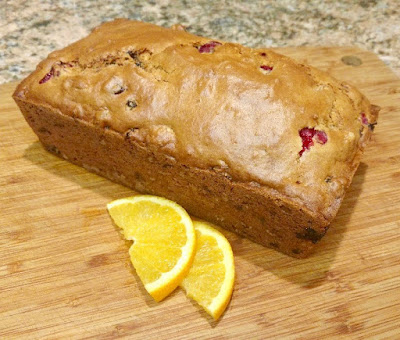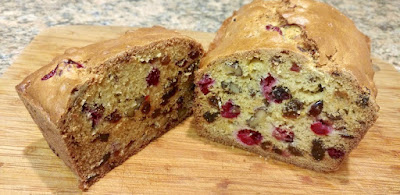
Recipe: Orange cranberry bread full of bright flavor

Oranges and cranberries complement each
other in this sunny tea bread. (Photos: Debbie
Arrington)
|
Oranges and cranberries naturally complement each other – and not just in Thanksgiving relish.
This simple tea bread makes the most of those bright and sunny flavors, and it’s good for you, too. Both oranges and cranberries are packed with vitamin C.
This recipe was inspired by Nicole Routhier’s excellent “Fruit Cookbook” (Workman Publishing, 1996). This version has been tweaked to play up the oranges and fresh citrus flavors. It takes about two to three fresh oranges to yield the necessary juice.
So close to the holidays, fresh cranberries are still available. (You may have some in the refrigerator right now.) By mixing the fruit with the flour, it stays suspended in the batter instead of sinking to the bottom of the baking pan. Avoid over-mixing; that brings out the gluten in the flour and toughens the tea bread.
Without too much sugar or butter, this tea bread comes out with a lovely golden crust – and lots of fruit flavor. It’s just what you need on a chilly winter morning.
Orange cranberry bread
Makes 1 loaf
Ingredients:
2 cups all-purpose flour
1 tablespoon baking powder
1 teaspoon baking soda
½ teaspoon salt
1 cup whole cranberries, fresh or frozen (thawed)
½ cup raisins
½ cup dried cranberries
½ cup walnuts, coarsely chopped
2 large eggs
½ cup sugar
¾ cup fresh orange juice (2 to 3 oranges)
1 tablespoon orange zest, finely grated
¼ cup (½ stick) butter or margarine, melted and cooled

Both dried and fresh cranberries add color and
sweet-tart flavor to this bread. |
Instructions:
Preheat oven to 350 degrees F.
Lightly grease loaf pan, preferably 8-1/2-by-4-1/2-by-2-1/2-inches; set aside.
In a large bowl, sift together flour, baking powder, baking soda and salt.
Add cranberries, raisins, dried cranberries and walnuts to flour mixture. Stir until well combined and fruit is covered with flour.
In another bowl, lightly beat eggs. Add sugar, then orange juice and zest. Stir in melted butter.
In the big bowl, make a well in the middle of the dry ingredients and add the juice mixture. With a wooden spoon, stir until dry ingredients are moistened. Don’t over-mix. Batter will be very thick.
Spread batter into prepared pan. Bake at 350 degrees for 1 hour or until top is golden brown and a skewer or toothpick inserted near the center comes out clean.
Let cool for 15 minutes. Remove from pan. Serve warm.
Comments
0 comments have been posted.Sacramento Digs Gardening to your inbox.
Sites We Like
Garden Checklist for week of July 21
Your garden needs you!
* Keep your vegetable garden watered, mulched and weeded. Water before 8 a.m. to reduce the chance of fungal infection and to conserve moisture.
* Feed vegetable plants bone meal, rock phosphate or other fertilizers high in phosphate to stimulate more blooms and fruiting. (But wait until daily high temperatures drop out of the 100s.)
* Don’t let tomatoes wilt or dry out completely. Give tomatoes a deep watering two to three times a week.
* Harvest vegetables promptly to encourage plants to produce more. Squash especially tends to grow rapidly in hot weather. Keep an eye on zucchini.
* Pinch back chrysanthemums for bushy plants and more flowers in September.
* Remove spent flowers from roses, daylilies and other bloomers as they finish flowering.
* Pinch off blooms from basil so the plant will grow more leaves.
* Cut back lavender after flowering to promote a second bloom.
* It's not too late to add a splash of color. Plant petunias, snapdragons, zinnias and marigolds.
* From seed, plant corn, pumpkins, radishes, winter squash and sunflowers.